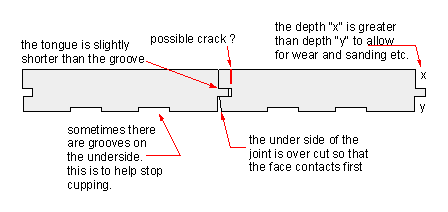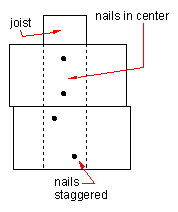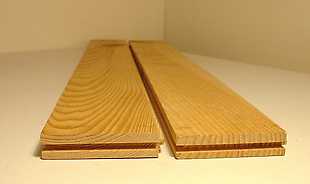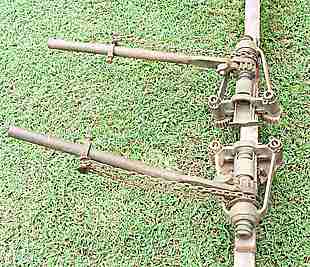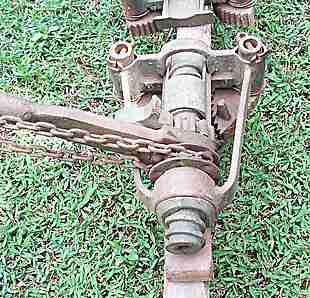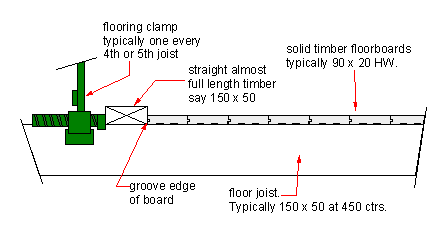 |
|||||||||||||||||
Timber Flooring
There are quite a few options when it comes to timber flooring and I'l try to list a few here.
Tongue and grooved boards
Above is a sketch of a couple of solid timber T&G floorboards. If you have a floor like this and you can see odd cracks where I have put the red line in the sketch, it means that your floor has been sanded a touch too thin and the grooves are starting to split. Be very careful if you are going to sand it and reseal. You could make the situation a lot worse. If you don't have the cracks, and you are going to hire a sander and do it yourself, take it easy with the coarse sanding. There is only so much you can take off, before you start to have problems. Laying a nailed through the face timber floor.Make absolutely sure that the boards are dry, test before you lay. They might have been kiln dried etc, but that was then, what about now? (I am talking about natural timber here, not man made floating floors). In the old days I fixed a lot of cypress pine flooring, which was naturally air dried, and always a bit of a problem as to the moisture content. When the wall framing and the roof was finished, quite often we would cut in the floor, laying it fairly loose,no nails, upside down. We would then carry on with the outside cladding, fixing windows, stairs etc. This gave the floor sometimes maybe two to four weeks extra to dry out. When we were happy that it was as dry as we could get it, we turned it face up and fixed it. This is no longer done, as just about all the flooring available now is kiln dried and comes in sealed packs, but if you are buying opened packs and you have the slightest doubts, get the moisture content checked.
I use 50 x 2.8 thick bullet head nails, usually two nails per board. All hand nailed, with my standard Estwing claw hammer. I nail them to a straight pencil line, no guessing. This is internal floors we are talking about, on external decks I stagger the nails. (The theory behind staggering them is that the joist is less likely to split along the line of nails). Standard boards are always cut and joined on a joist. At the joins I always pre-drill a hole for the nails. I use thinner nails, 2.0mm at the joins. The rest of the nails just get hammered in without pre-drilling, unless the the timber is very prone to splitting.
Cramp it and cramp it tight then fix it solid.
For laying a solid timber tongue and groove
floor a set of flooring clamps or cramps is essential. The clamp is held by the handle and swung into the joist. The two serrated teeth looking things grip the joist and as you apply pressure the teeth grip the timber. When the teeth are a bit worn, or if the joist timber is like the Selangan Batu we use,(hard as the hobs of hell), then a couple of belts on the gripping pawls with a hammer sets the clamp firm. For quick winding in and out the chain is used. The lever handle is used to apply the real pressure. These type of clamps are very fast to use. You can get them fixed and working in a very short time. I have seen other types, but nothing to beat these for speed of use, range of push and cramping power. They do of course mark the joists a bit.
Here is a sketch of the clamping setup. Always clamp against a
length of solid timber. Preferably almost the full length of the room
you are working in. To stop this happening, lay a length of timber across the boards being clamped, and stand on it to use your body weight to stop the boards lifting. When we have a section all cramped in position we nail it temporarily, with enough nails to hold it, then do another section. When all the floor is in place, then comes the fun part, nailing off. Try to get in a rhythm, swing the hammer from the end and let the swing do the work. Oh my poor back is aching just thinking about it. Don't punch the nails as soon as you have laid the floor. Leave the punching until just before the floor sander arrives, that way no bits of crap and grit get into the holes. Some floor sanders prefer to do the punching themselves. That way they know it is done right. A nail that is not punched deep enough can stuff up their sandpaper on the machine. I have heard of owner's and DIY people doing their own sanding and finishing. The machine sanders that I have seen in the hire places have been nothing like as big and good as the ones that a pro floor sander uses. By all means lay your own floorboards, but I would advise you to get a pro to do sand and seal. If you do tackle the job yourself, remember to keep the doors and windows closed when you are doing the coating. A wind or draft can and does set the sealer off too quick and gives the surface an uneven appearance. Leave flooring and go back to trim carpentry Not found it yet? Try this FAST SITE SEARCH or the whole web |
Other Carpentry and joinery related pages.
|
||||||||||||||||
|
|
|||||||||||||||||
|
Please Note! The information on this site is offered as a guide only! When we are talking about areas where building regulations or safety regulations could exist,the information here could be wrong for your area. It could be out of date! Regulations breed faster than rabbits! You must check your own local conditions. Copyright © Bill Bradley 2007-2012. All rights reserved. |
|||||||||||||||||
